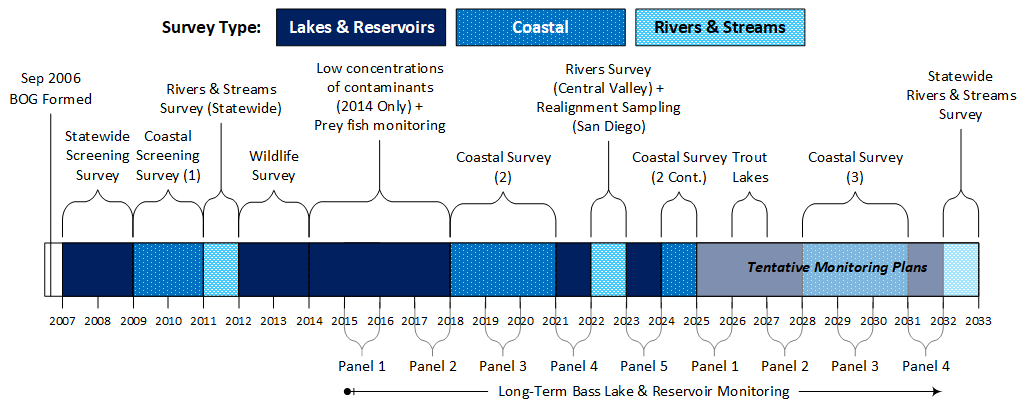Safe to Eat Workgroup
The Safe to Eat Workgroup (Workgroup), formerly known as the Bioaccumulation Oversight Group (BOG) is a subcommittee of the Water Boards' Surface Water Ambient Monitoring Program (SWAMP) Roundtable that provides oversight of SWAMP's statewide Bioaccumulation Monitoring Program. The mission of the Workgroup is to assess the impacts of contaminants in fish and shellfish on beneficial uses in California water bodies through statewide monitoring under SWAMP and perform syntheses of information from these statewide monitoring efforts and other studies.
The Workgroup is also a workgroup of the California Water Quality Monitoring Council, and in this role manages the Safe to Eat Portal and is a forum for coordination of bioaccumulation monitoring in California. Please see the STEW Charter for more information.
Long-term Monitoring Priorities Assessment Process – Goals
- Hear from Bioaccumulation Monitoring community: What are your data, information, and/or monitoring priorities over the coming years and how could the Program and STEW support?
- Discuss how we can most effectively use our SWAMP Bioaccumulation Monitoring Program funds and leverage other monitoring efforts and partnerships.
Ways to provide feedback during the Long-term Monitoring Priorities Assessment
- Tribes / Agencies / Community-Based Organizations (CBOs) interested in presenting the long-term monitoring priorities assessment discussions - email anna.holder@waterboards.ca.gov the following by Jan 1, 2024:
- Notification of interest in presenting in discussions, and how you would like to share information (e.g. External Partner Template or other format)
- A day/time your representative will be able to present the priorities at an upcoming STEW Meeting:
- Wed. Jan. 31, 2024 (9:30 am - 12:30 pm PT), OR
- Wed. Feb. 28, 2024 (1:30 pm - 4:30 pm PT)
- If you are unable to present but would still like to provide feedback - please complete the Bioaccumulation Monitoring Priorities Survey by Mar 1, 2024.
- Attend and participate in upcoming Long-term Monitoring Priorities Assessment & STEW Meetings; Join the STEW email list to stay informed and receive updates.
Background
In September 2006, SWAMP formed the Workgroup to develop plans for and to guide the implementation of SWAMP's statewide Bioaccumulation Monitoring Program. The California Water Quality Monitoring Council designated the Workgroup as its workgroup for assessing "Is it safe to eat fish and shellfish from our waters?" and directed this workgroup to develop the Safe to Eat Portal, which is devoted to this theme. The Workgroup convened a Bioaccumulation Peer Review Panel to provide evaluation and peer review of the Workgroup activities. The members of the Panel are internationally recognized authorities on bioaccumulation monitoring.
Since 2007, the Workgroup has been conducting surveys focused on collecting and analyzing fish tissue for mercury, legacy pesticides, and other bioaccumulated pollutants, such as PCBs, and assessing these data to provide insight into the safety of eating sport fish. These surveys have been conducted in lakes and reservoirs, rivers and streams, and coastal waters of California. From 2012 – 2013, the Workgroup conducted a study of methylmercury bioaccumulation in birds on California lakes and reservoirs (known as the wildlife survey). See the figure below for a timeline of the different bioaccumulation monitoring surveys the Workgroup has conducted and plans to conduct through 2032.
Other Workgroup activities have included reviews of historic bioaccumulation monitoring data and assessments in California, including:
A review of the historic Toxic Substance Monitoring (TSM) and State Mussel Watch (SMW) Programs
A review of historic bioaccumulation of pollutants and their impacts on fishing an aquatic wildlife in California waters
Membership
Membership is open to anyone with an interest in bioaccumulation, fish advisory development, and statewide bioaccumulation monitoring efforts.
Membership Benefits:
- Chance to connect with potential collaborators
- Opportunity to participate in statewide monitoring efforts
- Access to multiple datasets
- Contribute to science and resources supporting fish advisory development in California
Chance to connect with potential collaborators
Opportunity to participate in statewide monitoring efforts
Access to multiple datasets
Contribute to science and resources supporting fish advisory development in California
To join the Workgroup please contact the Bioaccumulation Monitoring Program Coordinator, Anna Holder.
Co-Chairs
- Jay Davis - San Francisco Estuary Institute
- Anna Holder - State Water Resources Control Board
Participating State Agencies
- California Department of Fish and Wildlife
- California Office of Environmental Health Hazard Assessment
- California Water Boards (State Water Board and nine Regional Water Quality Control Boards)
- State Water Resources Control Board (State Water Board)
- Region 1: North Coast
- Region 2: San Francisco
- Region 3: Central Coast
- Region 4: Los Angeles
- Region 5: Central Valley
- Region 6: Lahontan
- Region 7: Colorado River
- Region 8: Santa Ana
- Region 9: San Diego
Participating Federal Agencies
- U.S. Environmental Protection Agency
- U.S. Fish and Wildlife Service
- U.S. Geological Survey
Other Participating Organizations
- Moss Landing Marine Laboratories
- San Francisco Estuary Institute
- Southern California Coastal Water Research Project
SWAMP Bioaccumulation Peer Review Panel
- Bruce Monson, Minnesota Pollution Control Agency, St. Paul, MN
- Chris Schmitt - U.S. Geological Survey, Columbia, Missouri
- Harry Ohlendorf - Independent, Sacramento, California










Toolbox
SWAMP Bioaccumulation Monitoring Program
- Training Series
- Realignment
- Fact Sheet: English | Spanish | Simplified Chinese | Traditional Chinese | Hmong | Korean | Tagalog
- Flyer:English | Spanish | Simplified Chinese | Traditional Chinese | Hmong | Korean | Tagalog
Statewide SWAMP


